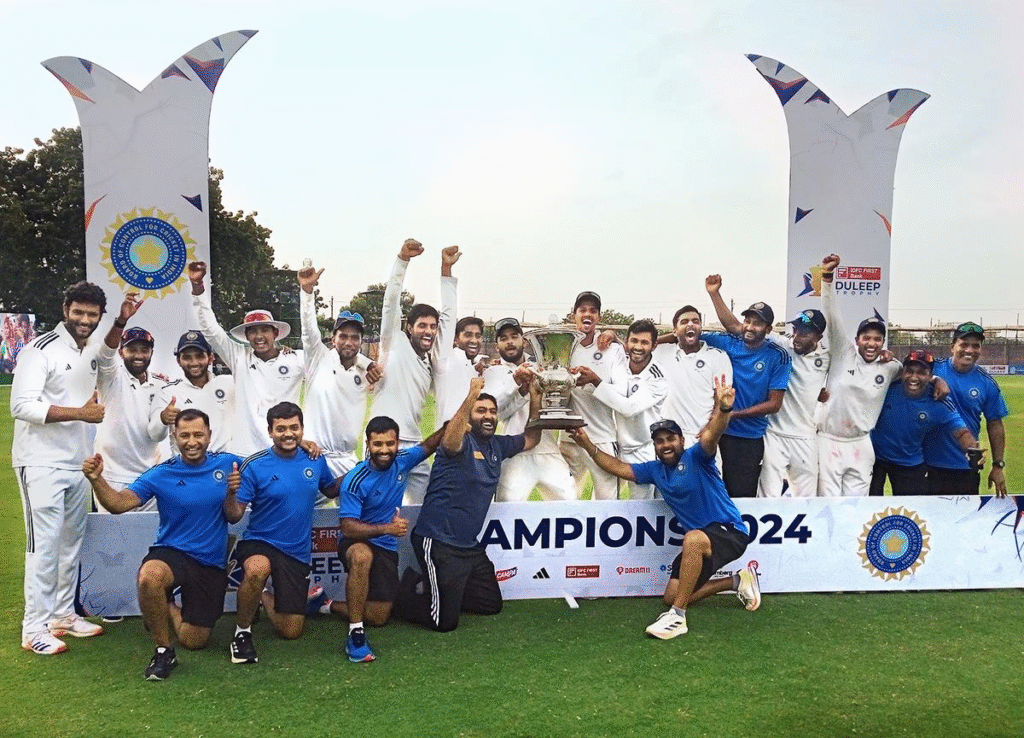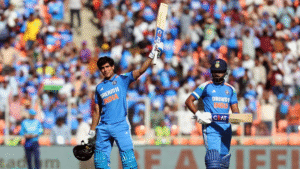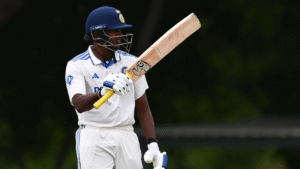What do you call a cricket tournament named after a player whose career was cut tragically short at just 25? The Duleep Trophy carries one of cricket’s most poignant stories – a tale of unfulfilled potential that became the foundation for Indian cricket’s most important structural innovation.

The Prince Who Could Have Been King
Kumar Shri Duleepsinhji wasn’t just another talented cricketer trading on his famous uncle Ranjitsinhji’s name. At Cheltenham College and Cambridge University, his natural gifts were already legendary. In May 1927, he destroyed Middlesex with 254 not out in just four hours – a Fenner’s ground record that announced his arrival as cricket royalty.
But early warning signs appeared when pneumonia struck during that same season, forcing him out of cricket temporarily. It should have been a red flag for what was to come in his career moving forward.
The Lord’s Debut That Stunned Cricket

The year 1930 marked the Duleep Trophy namesake’s greatest triumph. Picture the scene: England versus Australia at Lord’s, facing a formidable Australian attack that had just beaten England on home soil. Duleepsinhji walked out for his Ashes debut against bowlers like Tim Wall, Allen Fairfax, and Claire Grimmett.
What followed was pure cricket poetry. Contemporary accounts describe “a charming and prolonged exhibition of fluent driving, crisp cutting, and a neatness of deflection which gave more than a hint of Ranji himself.” His 173 on debut seemed destined to be the first of many Lord’s masterpieces.
Later that year, he achieved something only two other players in history had managed – scoring centuries in both innings of the Gentlemen vs Players match at Lord’s, joining an exclusive club with ‘Tip’ Foster and the King of Leicester.
Readers may also like: A Parting Note From A Test Cricket Enthusiast
The Structural Problem That Demanded Innovation
While Duleepsinhji was establishing himself as one of England’s finest batsmen, Indian cricket faced a crisis that would eventually make his name immortal through the Duleep Trophy.
Before 1934, Indian cricket had a massive structural flaw. Only about 50 Indians could access “big cricket” through the Bombay Pentangular tournament between different communities – Europeans, Hindus, Muslims, Parsees, and The Rest.
On November 4th, 1934, everything changed when the Ranji Trophy was born. Suddenly, over 200 young cricketers had opportunities in its first year alone. But the knockout system within zones created another problem – talented players in weak teams could see their entire season end with one bad match.
Solution: Duleep Trophy

Cricket administrators needed a tournament that would give the best players multiple opportunities regardless of their team’s initial performance. The inter-zone tournament for the Duleep Trophy became that solution.
But why name this crucial innovation after Duleepsinhji? The answer reveals cricket’s most touching tribute to unfulfilled potential.
The story behind this decision – and the tragic circumstances that ended Duleepsinhji’s career at just 25 – forms the heart of our exclusive members-only deep dive into cricket history.
The Legacy That Lives On
Today, the Duleep Trophy continues serving its original purpose – ensuring that India’s most talented cricketers get additional opportunities to showcase their skills beyond state boundaries. From addressing structural flaws in the knockout system to its current format bridging different zones, the tournament remains true to the spirit of Duleepsinhji.
Watch the complete breakdown here:
What You’ll Discover in Our Members-Only Video
The complete story behind the Duleep Trophy includes:
- The shocking health crisis that ended Duleepsinhji’s career prematurely
- His incredible statistical achievements that placed him among England’s elite batters
- How his unfulfilled potential perfectly symbolized the plight of talented Indian cricketers
- The exact moment cricket administrators decided to honor his memory
- Rare insights from first-hand accounts and cricket archives
Want to uncover the full story? Our comprehensive video breakdown dives deep into cricket’s archives, including first-hand accounts and contemporary writings, to reveal how personal tragedy became sporting innovation.
A Tournament Born from Tragedy
The Duleep Trophy represents more than just another cricket tournament. It stands as cricket’s most moving testament to the belief that talent should never be wasted due to circumstances beyond a player’s control.
K.S. Duleepsinhji may have played his last match at just 25, but through this tournament, his name lives on as a symbol of opportunity, excellence, and the beautiful game that connects all of cricket-loving India.










